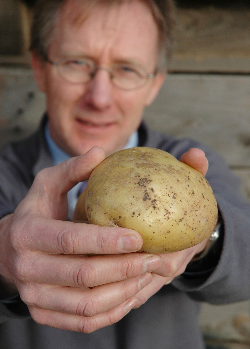
Amistar treatment at planting can buy potato growers an extra two weeks growing season without increasing the risk of black dot, according to the latest independent research by BPC Plant Pathologist, Jeff Peters.
An assessment of trials for the BPC-funded Skin Finish and Black Dot projects have shown the length of the growing season is the primary determinate of black dot infection on tubers, not the date of burndown or harvest as had previously been assumed.
Dr Peters has calculated Estima crops have an average 110 day growing period from emergence to lifting to maintain skin infection levels at around the 10% outgrade level for pre-pack contracts; Maris Piper has slightly longer at 120 days. In practice, the burndown date and interval from burndown to lifting has proven relatively unimportant, he reports.
"By reducing the level of initial inoculum Amistar shifts the curve of disease build up in the right direction," said Dr Peters. "Growers are effectively buying themselves a two week delay in disease build-up."
Dr Peters also believes that with good store management, any further development of black dot in store can be virtually eliminated. The key is to pull down crop temperatures quickly – ideally by 0.5ºC per day as soon as the store is loaded, provided there is minimal risk of soft rots developing. Once down to around 3ºC, research at the BPC's Sutton Bridge Experimental Unit has shown there should be no increase in the severity or extent of black dot infection on tuber surface.
Growers can use this information to tailor crop management, according to the risk of black dot and the varietal susceptibility, advises Dr Peters; if a crop of Estima is likely to take more than 110 days for tubers to reach contract specification, for example, then Amistar treatment will be fully justified.
DNA diagnostics
The decision process will be further helped by the BPC-funded development of soil testing, which could provide a valuable insight into the level of risk for individual fields, adds Dr Peters. Although the DNA testing techniques have been established by SCRI, SAC and CSL and the physical capability is in place with those laboratories, he still believes the tests will require two or three seasons' validation before reliable thresholds can be set.
A widespread soil testing programme will reveal the true extent of the soil borne Colletotrichum coccodes black dot pathogen, although initial testing for the Black Dot Project and diagnosis development has shown the vast majority of potato soils are already infested.
Once soil is contaminated, seed-borne black dot inoculum is of relatively little importance," adds Dr Peters. But if growers do have clean soil he urges them to do everything possible to protect it. "Trials show seed-borne infection may not have much effect on the skin quality of this year's crop, but its legacy will be to leave a higher level of soil borne disease in the field, which could have major implications for future crops.
New Amistar & seed treatment combinations
Syngenta Technical Manager, Jon Ogborn, reports the company has new guidelines for the use of Amistar in conjunction with seed treatments this season.
"Where seed has seed-borne Rhizoctonia infection, consider the use of pencycuron dust at planting, or an in-store Rhizoctonia treatment prior to Amistar application," he advises. "But growers should avoid the use of imazalil + pencycuron dust, or any liquid seed treatment, at planting with Amistar."
